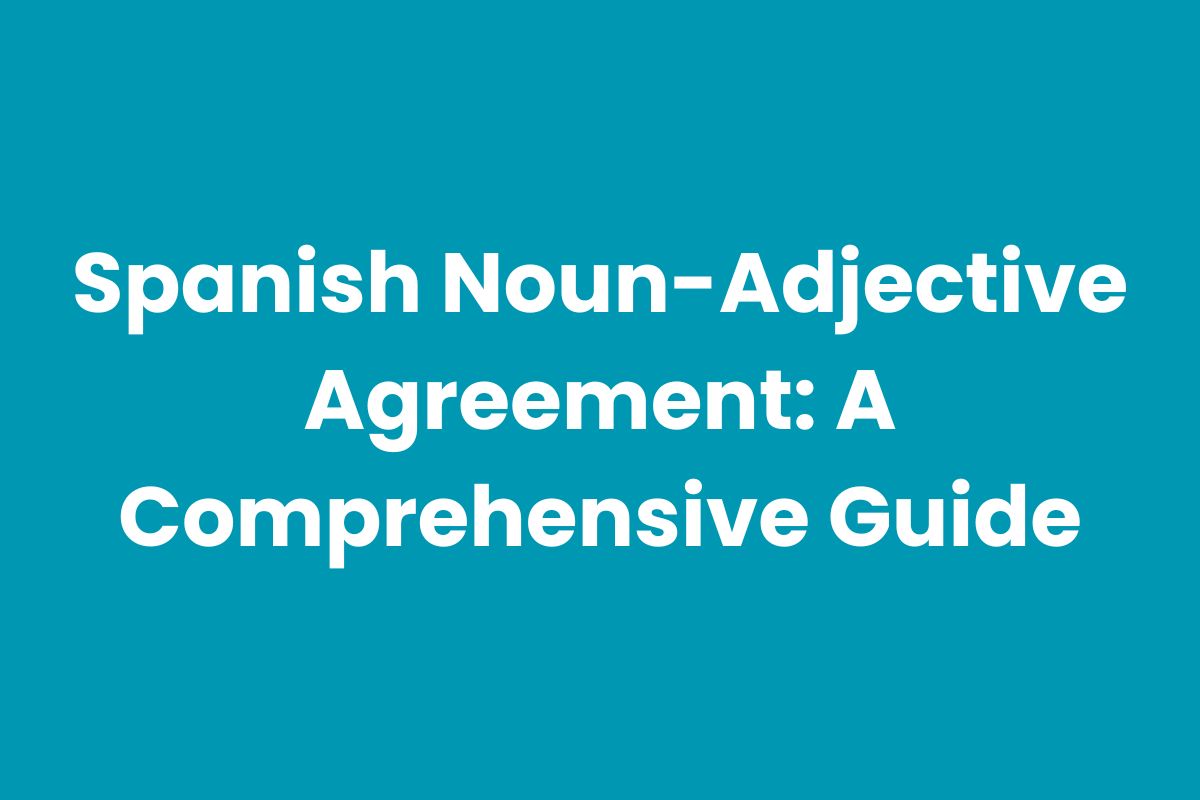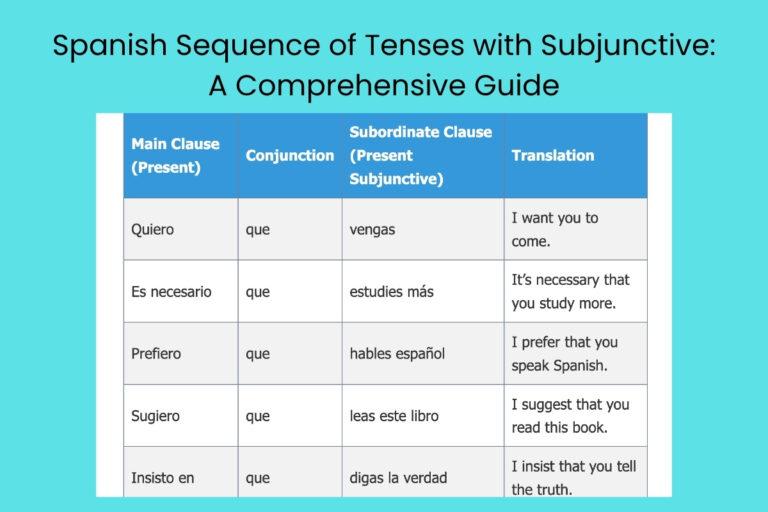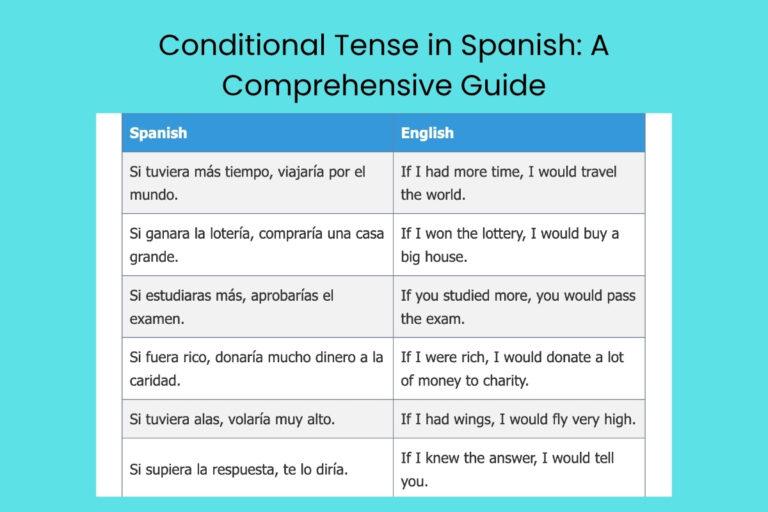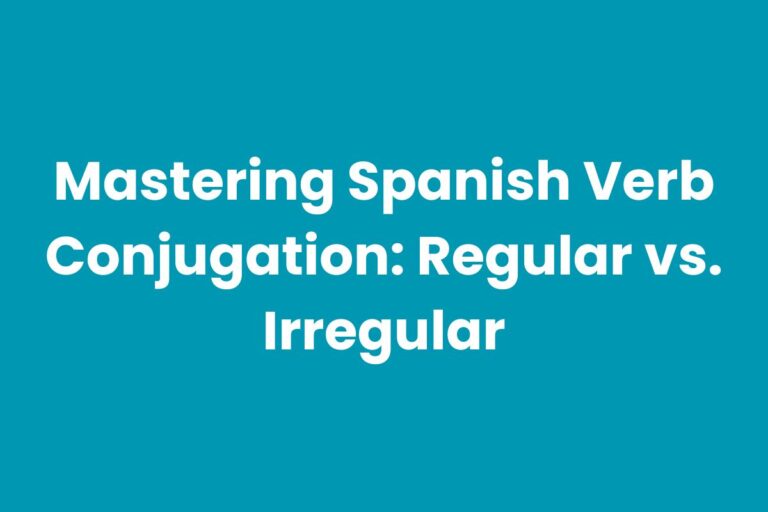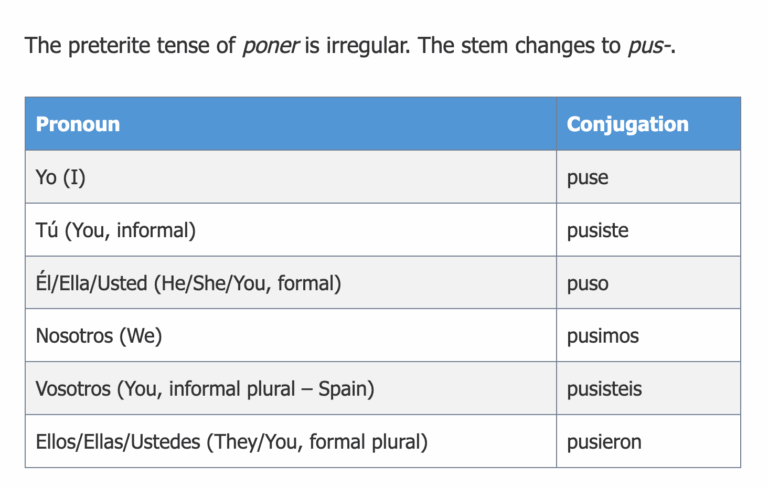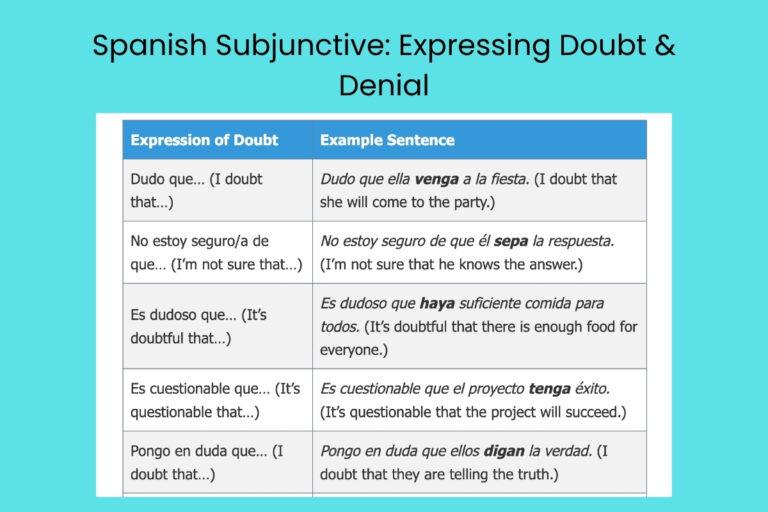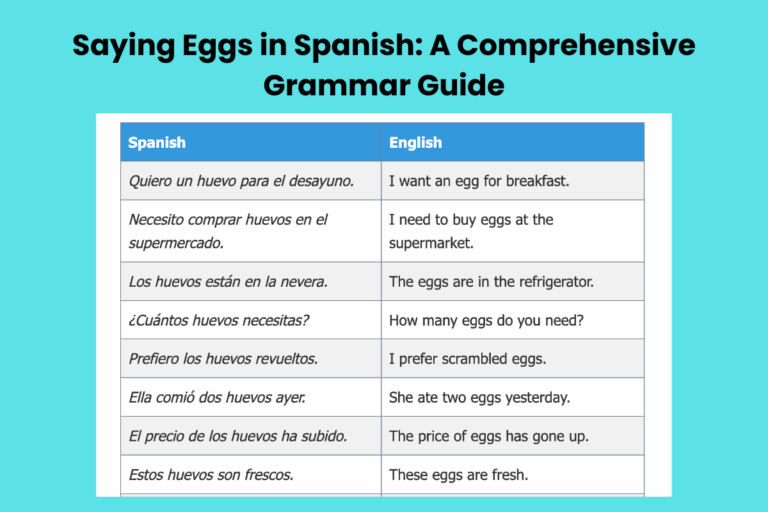Spanish Noun-Adjective Agreement: A Comprehensive Guide
Mastering noun-adjective agreement is crucial for achieving fluency and accuracy in Spanish. This grammatical concept ensures that adjectives correctly modify nouns by matching them in both gender and number.
Understanding and applying these rules is essential for constructing grammatically sound sentences and avoiding common errors. This guide is designed for Spanish learners of all levels, from beginners to advanced students, providing a clear and structured approach to mastering this fundamental aspect of Spanish grammar.
Whether you’re just starting out or looking to refine your skills, this article will provide the knowledge and practice you need to confidently use noun-adjective agreement.
Table of Contents
- Definition of Noun-Adjective Agreement
- Structural Breakdown
- Gender (Masculine and Feminine)
- Number (Singular and Plural)
- Types and Categories
- Simple Agreement
- Agreement with Compound Nouns
- Agreement with Pronouns
- Examples of Noun-Adjective Agreement
- Masculine Singular Examples
- Feminine Singular Examples
- Masculine Plural Examples
- Feminine Plural Examples
- Mixed-Gender Plural Examples
- Usage Rules
- Basic Agreement Rules
- Exceptions to the Rules
- Adjectives Before Nouns
- Common Mistakes
- Gender Agreement Mistakes
- Number Agreement Mistakes
- Practice Exercises
- Exercise 1: Fill in the Blanks
- Exercise 2: Correct the Errors
- Exercise 3: Translation
- Advanced Topics
- Agreement with Collective Nouns
- Agreement with Uncountable Nouns
- Agreement with Proper Nouns
- FAQ
- Conclusion
Definition of Noun-Adjective Agreement
Noun-adjective agreement, known as concordancia in Spanish, is a fundamental grammatical rule stating that adjectives must agree with the nouns they modify in both gender (masculine or feminine) and number (singular or plural). This agreement is crucial for ensuring that sentences are grammatically correct and understandable. It reflects the relationship between a noun and its descriptive qualities, making the language flow logically.
In Spanish, nouns are inherently either masculine or feminine, regardless of whether they refer to animate or inanimate objects. Adjectives must change their form to match the gender of the noun they describe.
Similarly, if the noun is singular, the adjective must be singular, and if the noun is plural, the adjective must also be plural. Failing to adhere to this agreement can lead to confusion and grammatical errors.
Structural Breakdown
The structural breakdown of noun-adjective agreement involves understanding how adjectives change based on the gender and number of the nouns they modify. The typical word order in Spanish is Noun + Adjective, although there are exceptions where the adjective precedes the noun, often for stylistic reasons or to emphasize a particular quality. Regardless of the word order, the agreement rule remains constant.
The agreement process involves the following steps:
- Identify the noun: Determine the noun that the adjective is modifying.
- Determine the gender of the noun: Is the noun masculine or feminine?
- Determine the number of the noun: Is the noun singular or plural?
- Adjust the adjective: Change the adjective to match the noun’s gender and number.
Gender (Masculine and Feminine)
In Spanish, nouns are classified as either masculine or feminine. There are some general patterns to help determine a noun’s gender, but there are also many exceptions. Typically, nouns ending in -o are masculine, and nouns ending in -a are feminine. However, this is not a hard and fast rule.
Examples:
- El libro (masculine) – The book
- La casa (feminine) – The house
Adjectives must change their ending to match the gender of the noun. For most adjectives, the masculine form ends in -o, and the feminine form ends in -a.
Examples:
- El libro rojo (masculine) – The red book
- La casa roja (feminine) – The red house
Adjectives that end in -e, -ista, or consonants generally do not change for gender. Instead, they remain the same for both masculine and feminine nouns in the singular form. However, they still need to agree in number.
Examples:
- El hombre inteligente (masculine) – The intelligent man
- La mujer inteligente (feminine) – The intelligent woman
Number (Singular and Plural)
Number refers to whether a noun is singular (one) or plural (more than one). Adjectives must also agree in number with the nouns they modify.
To make a noun plural, you typically add -s to nouns that end in a vowel and -es to nouns that end in a consonant.
Examples:
- El libro (singular) – The book
- Los libros (plural) – The books
- La casa (singular) – The house
- Las casas (plural) – The houses
Adjectives follow the same rules for pluralization. If an adjective ends in a vowel, add -s. If it ends in a consonant, add -es.
Examples:
- El libro rojo (singular) – The red book
- Los libros rojos (plural) – The red books
- La casa roja (singular) – The red house
- Las casas rojas (plural) – The red houses
Adjectives that end in -z change the -z to -ces in the plural form.
Example:
- El lápiz feliz (singular) – The happy pencil
- Los lápices felices (plural) – The happy pencils
Types and Categories
Simple Agreement
Simple agreement is the most straightforward type, where a single adjective modifies a single noun. The adjective must agree in both gender and number with the noun.
Examples:
- El perro pequeño (masculine singular) – The small dog
- La manzana roja (feminine singular) – The red apple
- Los perros pequeños (masculine plural) – The small dogs
- Las manzanas rojas (feminine plural) – The red apples
Agreement with Compound Nouns
When an adjective modifies a compound noun (two or more nouns joined together), the agreement can be a bit more complex. If the nouns are of the same gender, the adjective agrees with the gender of the nouns and is plural.
If the nouns are of different genders, the adjective typically takes the masculine plural form.
Examples:
- La mesa y la silla blancas (feminine plural) – The white table and chair
- El libro y el cuaderno interesantes (masculine plural) – The interesting book and notebook
- La mesa y el libro interesantes (masculine plural) – The interesting table and book
Agreement with Pronouns
Adjectives must also agree with pronouns in gender and number. This is particularly important when using demonstrative or possessive pronouns.
Examples:
- Él es alto (masculine singular) – He is tall
- Ella es alta (feminine singular) – She is tall
- Ellos son altos (masculine plural) – They are tall
- Ellas son altas (feminine plural) – They are tall
Examples of Noun-Adjective Agreement
The following tables provide extensive examples of noun-adjective agreement in various contexts. Each table focuses on a specific gender and number combination, illustrating how adjectives change to match the nouns they modify.
Masculine Singular Examples
This table showcases examples of masculine singular nouns with agreeing adjectives.
| Noun (Masculine Singular) | Adjective (Masculine Singular) | Example Sentence | Translation |
|---|---|---|---|
| El libro (The book) | Interesante (Interesting) | El libro es interesante. | The book is interesting. |
| El coche (The car) | Nuevo (New) | El coche es nuevo. | The car is new. |
| El perro (The dog) | Pequeño (Small) | El perro es pequeño. | The dog is small. |
| El árbol (The tree) | Alto (Tall) | El árbol es alto. | The tree is tall. |
| El sol (The sun) | Brillante (Bright) | El sol es brillante. | The sun is bright. |
| El día (The day) | Bonito (Beautiful) | El día es bonito. | The day is beautiful. |
| El hombre (The man) | Fuerte (Strong) | El hombre es fuerte. | The man is strong. |
| El café (The coffee) | Caliente (Hot) | El café está caliente. | The coffee is hot. |
| El reloj (The watch) | Caro (Expensive) | El reloj es caro. | The watch is expensive. |
| El examen (The exam) | Difícil (Difficult) | El examen es difícil. | The exam is difficult. |
| El problema (The problem) | Complicado (Complicated) | El problema es complicado. | The problem is complicated. |
| El restaurante (The restaurant) | Bueno (Good) | El restaurante es bueno. | The restaurant is good. |
| El tiempo (The weather) | Agradable (Pleasant) | El tiempo es agradable. | The weather is pleasant. |
| El trabajo (The job) | Interesante (Interesting) | El trabajo es interesante. | The job is interesting. |
| El proyecto (The project) | Importante (Important) | El proyecto es importante. | The project is important. |
| El edificio (The building) | Moderno (Modern) | El edificio es moderno. | The building is modern. |
| El zapato (The shoe) | Negro (Black) | El zapato es negro. | The shoe is black. |
| El vaso (The glass) | Vacío (Empty) | El vaso está vacío. | The glass is empty. |
| El país (The country) | Grande (Big) | El país es grande. | The country is big. |
| El idioma (The language) | Fácil (Easy) | El idioma es fácil. | The language is easy. |
| El juego (The game) | Divertido (Fun) | El juego es divertido. | The game is fun. |
| El río (The river) | Largo (Long) | El río es largo. | The river is long. |
| El pastel (The cake) | Delicioso (Delicious) | El pastel es delicioso. | The cake is delicious. |
| El museo (The museum) | Famoso (Famous) | El museo es famoso. | The museum is famous. |
Feminine Singular Examples
This table showcases examples of feminine singular nouns with agreeing adjectives.
| Noun (Feminine Singular) | Adjective (Feminine Singular) | Example Sentence | Translation |
|---|---|---|---|
| La casa (The house) | Grande (Big) | La casa es grande. | The house is big. |
| La flor (The flower) | Bonita (Pretty) | La flor es bonita. | The flower is pretty. |
| La mesa (The table) | Pequeña (Small) | La mesa es pequeña. | The table is small. |
| La silla (The chair) | Cómoda (Comfortable) | La silla es cómoda. | The chair is comfortable. |
| La ventana (The window) | Abierta (Open) | La ventana está abierta. | The window is open. |
| La ciudad (The city) | Antigua (Old) | La ciudad es antigua. | The city is old. |
| La canción (The song) | Popular (Popular) | La canción es popular. | The song is popular. |
| La comida (The food) | Deliciosa (Delicious) | La comida es deliciosa. | The food is delicious. |
| La pregunta (The question) | Fácil (Easy) | La pregunta es fácil. | The question is easy. |
| La respuesta (The answer) | Correcta (Correct) | La respuesta es correcta. | The answer is correct. |
| La lección (The lesson) | Importante (Important) | La lección es importante. | The lesson is important. |
| La película (The movie) | Entretenida (Entertaining) | La película es entretenida. | The movie is entertaining. |
| La noche (The night) | Oscura (Dark) | La noche es oscura. | The night is dark. |
| La playa (The beach) | Hermosa (Beautiful) | La playa es hermosa. | The beach is beautiful. |
| La música (The music) | Suave (Soft) | La música es suave. | The music is soft. |
| La puerta (The door) | Cerrada (Closed) | La puerta está cerrada. | The door is closed. |
| La revista (The magazine) | Interesante (Interesting) | La revista es interesante. | The magazine is interesting. |
| La ventana (The window) | Limpia (Clean) | La ventana está limpia. | The window is clean. |
| La historia (The story) | Larga (Long) | La historia es larga. | The story is long. |
| La tarea (The homework) | Difícil (Difficult) | La tarea es difícil. | The homework is difficult. |
| La idea (The idea) | Buena (Good) | La idea es buena. | The idea is good. |
| La carta (The letter) | Escrita (Written) | La carta está escrita. | The letter is written. |
| La sopa (The soup) | Caliente (Hot) | La sopa está caliente. | The soup is hot. |
| La falda (The skirt) | Azul (Blue) | La falda es azul. | The skirt is blue. |
Masculine Plural Examples
This table showcases examples of masculine plural nouns with agreeing adjectives.
| Noun (Masculine Plural) | Adjective (Masculine Plural) | Example Sentence | Translation |
|---|---|---|---|
| Los libros (The books) | Interesantes (Interesting) | Los libros son interesantes. | The books are interesting. |
| Los coches (The cars) | Nuevos (New) | Los coches son nuevos. | The cars are new. |
| Los perros (The dogs) | Pequeños (Small) | Los perros son pequeños. | The dogs are small. |
| Los árboles (The trees) | Altos (Tall) | Los árboles son altos. | The trees are tall. |
| Los soles (The suns) | Brillantes (Bright) | Los soles son brillantes. | The suns are bright. |
| Los días (The days) | Bonitos (Beautiful) | Los días son bonitos. | The days are beautiful. |
| Los hombres (The men) | Fuertes (Strong) | Los hombres son fuertes. | The men are strong. |
| Los cafés (The coffees) | Calientes (Hot) | Los cafés están calientes. | The coffees are hot. |
| Los relojes (The watches) | Caros (Expensive) | Los relojes son caros. | The watches are expensive. |
| Los exámenes (The exams) | Difíciles (Difficult) | Los exámenes son difíciles. | The exams are difficult. |
| Los problemas (The problems) | Complicados (Complicated) | Los problemas son complicados. | The problems are complicated. |
| Los restaurantes (The restaurants) | Buenos (Good) | Los restaurantes son buenos. | The restaurants are good. |
| Los tiempos (The weathers) | Agradables (Pleasant) | Los tiempos son agradables. | The weathers are pleasant. |
| Los trabajos (The jobs) | Interesantes (Interesting) | Los trabajos son interesantes. | The jobs are interesting. |
| Los proyectos (The projects) | Importantes (Important) | Los proyectos son importantes. | The projects are important. |
| Los edificios (The buildings) | Modernos (Modern) | Los edificios son modernos. | The buildings are modern. |
| Los zapatos (The shoes) | Negros (Black) | Los zapatos son negros. | The shoes are black. |
| Los vasos (The glasses) | Vacíos (Empty) | Los vasos están vacíos. | The glasses are empty. |
| Los países (The countries) | Grandes (Big) | Los países son grandes. | The countries are big. |
| Los idiomas (The languages) | Fáciles (Easy) | Los idiomas son fáciles. | The languages are easy. |
| Los juegos (The games) | Divertidos (Fun) | Los juegos son divertidos. | The games are fun. |
| Los ríos (The rivers) | Largos (Long) | Los ríos son largos. | The rivers are long. |
| Los pasteles (The cakes) | Deliciosos (Delicious) | Los pasteles son deliciosos. | The cakes are delicious. |
| Los museos (The museums) | Famosos (Famous) | Los museos son famosos. | The museums are famous. |
Feminine Plural Examples
This table showcases examples of feminine plural nouns with agreeing adjectives.
| Noun (Feminine Plural) | Adjective (Feminine Plural) | Example Sentence | Translation |
|---|---|---|---|
| Las casas (The houses) | Grandes (Big) | Las casas son grandes. | The houses are big. |
| Las flores (The flowers) | Bonitas (Pretty) | Las flores son bonitas. | The flowers are pretty. |
| Las mesas (The tables) | Pequeñas (Small) | Las mesas son pequeñas. | The tables are small. |
| Las sillas (The chairs) | Cómodas (Comfortable) | Las sillas son cómodas. | The chairs are comfortable. |
| Las ventanas (The windows) | Abiertas (Open) | Las ventanas están abiertas. | The windows are open. |
| Las ciudades (The cities) | Antiguas (Old) | Las ciudades son antiguas. | The cities are old. |
| Las canciones (The songs) | Populares (Popular) | Las canciones son populares. | The songs are popular. |
| Las comidas (The foods) | Deliciosas (Delicious) | Las comidas son deliciosas. | The foods are delicious. |
| Las preguntas (The questions) | Fáciles (Easy) | Las preguntas son fáciles. | The questions are easy. |
| Las respuestas (The answers) | Correctas (Correct) | Las respuestas son correctas. | The answers are correct. |
| Las lecciones (The lessons) | Importantes (Important) | Las lecciones son importantes. | The lessons are important. |
| Las películas (The movies) | Entretenidas (Entertaining) | Las películas son entretenidas. | The movies are entertaining. |
| Las noches (The nights) | Oscuras (Dark) | Las noches son oscuras. | The nights are dark. |
| Las playas (The beaches) | Hermosas (Beautiful) | Las playas son hermosas. | The beaches are beautiful. |
| Las músicas (The musics) | Suaves (Soft) | Las músicas son suaves. | The musics are soft. |
| Las puertas (The doors) | Cerradas (Closed) | Las puertas están cerradas. | The doors are closed. |
| Las revistas (The magazines) | Interesantes (Interesting) | Las revistas son interesantes. | The magazines are interesting. |
| Las ventanas (The windows) | Limpias (Clean) | Las ventanas están limpias. | The windows are clean. |
| Las historias (The stories) | Largas (Long) | Las historias son largas. | The stories are long. |
| Las tareas (The homeworks) | Difíciles (Difficult) | Las tareas son difíciles. | The homeworks are difficult. |
| Las ideas (The ideas) | Buenas (Good) | Las ideas son buenas. | The ideas are good. |
| Las cartas (The letters) | Escritas (Written) | Las cartas están escritas. | The letters are written. |
| Las sopas (The soups) | Calientes (Hot) | Las sopas están calientes. | The soups are hot. |
| Las faldas (The skirts) | Azules (Blue) | Las faldas son azules. | The skirts are blue. |
Mixed-Gender Plural Examples
When referring to a group with both masculine and feminine nouns, Spanish defaults to the masculine plural form for the adjective.
| Nouns (Mixed Gender Plural) | Adjective (Masculine Plural) | Example Sentence | Translation |
|---|---|---|---|
| Los niños y las niñas (The boys and the girls) | Felices (Happy) | Los niños y las niñas están felices. | The boys and the girls are happy. |
| Los padres y las madres (The fathers and the mothers) | Orgullosos (Proud) | Los padres y las madres están orgullosos. | The fathers and the mothers are proud. |
| Los abuelos y las abuelas (The grandfathers and the grandmothers) | Cansados (Tired) | Los abuelos y las abuelas están cansados. | The grandfathers and the grandmothers are tired. |
| Los hermanos y las hermanas (The brothers and the sisters) | Unidos (United) | Los hermanos y las hermanas están unidos. | The brothers and the sisters are united. |
| Los tíos y las tías (The Uncles and the Aunts) | Generosos (Generous) | Los tíos y las tías son generosos. | The uncles and the aunts are generous. |
| Los amigos y las amigas (The male friends and the female friends) | Divertidos (Fun) | Los amigos y las amigas son divertidos. | The male friends and the female friends are fun. |
| Los estudiantes y las estudiantes (The male students and the female students) | Inteligentes (Intelligent) | Los estudiantes y las estudiantes son inteligentes. | The male students and the female students are intelligent. |
Usage Rules
Basic Agreement Rules
The fundamental rules for noun-adjective agreement are straightforward but essential to follow:
- Gender Agreement: Adjectives must match the gender of the noun (masculine or feminine).
- Number Agreement: Adjectives must match the number of the noun (singular or plural).
- Word Order: Typically, adjectives follow the noun in Spanish, but the agreement rule remains the same regardless of the order.
- Mixed Genders: When referring to a group of mixed genders, use the masculine plural form of the adjective.
Exceptions to the Rules
While the rules for noun-adjective agreement are generally consistent, there are some exceptions to be aware of:
- Adjectives ending in -e, -ista, or consonants: These adjectives do not change based on gender in the singular form but must still agree in number.
- Nouns with irregular gender: Some nouns have genders that do not align with their endings (e.g., el problema is masculine despite ending in -a).
- Compound nouns: The agreement can be more complex, especially when the nouns are of different genders.
Adjectives Before Nouns
While the typical word order in Spanish is noun + adjective, adjectives can sometimes come before nouns. This often occurs for emphasis or stylistic reasons.
However, the agreement rule remains the same.
Examples:
- Un buen hombre (A good man) – Here, buen is a shortened form of bueno and comes before the noun.
- Una gran mujer (A great woman) – Here, gran is a shortened form of grande and comes before the noun.
Common Mistakes
Noun-adjective agreement is a common area of error for Spanish learners. Understanding these common mistakes can help you avoid them.
Gender Agreement Mistakes
One of the most frequent errors is incorrectly assigning gender to a noun, leading to incorrect adjective agreement.
Example:
- Incorrect: El casa blanco blanco blanca
- Correct: La casa blanca
- Translation: The white house.
Number Agreement Mistakes
Another common mistake is failing to make the adjective plural when the noun is plural.
Example:
- Incorrect: Los libro interesante interesante interesantes
- Correct: Los libros interesantes
- Translation: The interesting books.
Practice Exercises
To reinforce your understanding of noun-adjective agreement, complete the following exercises.
Exercise 1: Fill in the Blanks
Complete the following sentences by filling in the blanks with the correct form of the adjective provided.
Exercise 2: Correct the Errors
Identify and correct the errors in noun-adjective agreement in the following sentences.
Exercise 3: Translation
Translate the following English sentences into Spanish, paying close attention to noun-adjective agreement.
Advanced Topics
For advanced learners, understanding noun-adjective agreement in more complex situations is crucial. This section covers agreement with collective nouns, uncountable nouns, and proper nouns.
Agreement with Collective Nouns
Collective nouns refer to a group of individuals or items as a single entity. In Spanish, the adjective agrees with the collective noun in gender and number. Common collective nouns include la gente (the people), la familia (the family), and el equipo (the team).
Examples:
- La gente está feliz (The people are happy).
- El equipo es fuerte (The team is strong).
- La familia es unida (The family is united).
Agreement with Uncountable Nouns
Uncountable nouns, also known as mass nouns, refer to things that cannot be counted as individual units (e.g., water, sand, information). These nouns are always singular, and adjectives must agree with them in gender and number.
Examples:
- El agua fría (The cold water).
- La arena fina (The fine sand).
- La información importante (The important information).
Agreement with Proper Nouns
Proper nouns are specific names of people, places, or things. When adjectives modify proper nouns, they must still agree in gender and number, although this is less common.
Examples:
- La vieja España (Old Spain).
- El gran Madrid (Great Madrid).
FAQ
Conclusion
Mastering noun-adjective agreement is a fundamental step toward achieving fluency and accuracy in Spanish. By understanding the rules and practicing regularly, you can avoid common mistakes and communicate more effectively.
Remember to pay attention to both gender and number, and don’t hesitate to consult resources when unsure. With consistent effort, you’ll develop a strong command of this essential grammatical concept, enhancing your overall proficiency in Spanish.

